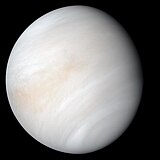Gambar:PIA23791-Venus-RealAndEnhancedContrastViews-20200608 (cropped).jpg

Ukuran ieu pramidang: 600 × 600 pixel. Resolusi lianna: 240 × 240 pixel | 480 × 480 pixel | 768 × 768 pixel | 1.096 × 1.096 pixel.
Berkas asli (1.096 × 1.096 piksel, ukuran koropak: 30 KB, tipeu MIME: image/jpeg)
Jujutan berkas
Klik dina titimangsa pikeun nempo koropak nu aya dina mangsa éta.
| Titimangsa | Miniatur | Ukuran | Pamaké | Kamandang | |
|---|---|---|---|---|---|
| kiwari | 9 Juli 2020 23.40 |  | 1.096 × 1.096 (30 KB) | PhilipTerryGraham | File:PIA23791-Venus-RealAndEnhancedContrastViews-20200608.jpg cropped 51 % horizontally using CropTool with precise mode. |
Pamakéan berkas
Ieu berkas dipaké ku kaca di handap:
Pamakéan berkas sajagat
Wiki lianna anu maké ieu berkas:
- Pamakéan di ary.wikipedia.org
- Pamakéan di arz.wikipedia.org
- Pamakéan di ast.wikipedia.org
- Pamakéan di as.wikipedia.org
- Pamakéan di awa.wikipedia.org
- Pamakéan di azb.wikipedia.org
- Pamakéan di az.wikipedia.org
- Pamakéan di ban.wikipedia.org
- Pamakéan di bat-smg.wikipedia.org
- Pamakéan di ba.wikipedia.org
- Pamakéan di bcl.wikipedia.org
- Pamakéan di be-tarask.wikipedia.org
- Pamakéan di be.wikipedia.org
- Pamakéan di bew.wikipedia.org
- Pamakéan di bg.wikipedia.org
- Pamakéan di bh.wikipedia.org
- Pamakéan di bjn.wikipedia.org
- Pamakéan di bn.wikipedia.org
- Pamakéan di bo.wikipedia.org
- Pamakéan di br.wikipedia.org
- Pamakéan di bs.wikipedia.org
- Pamakéan di btm.wikipedia.org
- Pamakéan di bxr.wikipedia.org
- Pamakéan di ca.wikipedia.org
- Pamakéan di cdo.wikipedia.org
- Pamakéan di ceb.wikipedia.org
- Pamakéan di ce.wikipedia.org
- Pamakéan di chr.wikipedia.org
- Pamakéan di ckb.wikipedia.org
- Pamakéan di co.wikipedia.org
- Pamakéan di crh.wikipedia.org
- Pamakéan di cr.wikipedia.org
- Pamakéan di csb.wikipedia.org
- Pamakéan di cs.wikipedia.org
- Pamakéan di cu.wikipedia.org
- Pamakéan di cv.wikipedia.org
- Pamakéan di cy.wikipedia.org
- Pamakéan di dag.wikipedia.org
- Pamakéan di da.wikipedia.org
- Pamakéan di de.wikipedia.org
- Pamakéan di dga.wikipedia.org
- Pamakéan di din.wikipedia.org
- Pamakéan di diq.wikipedia.org
- Pamakéan di dsb.wikipedia.org
- Pamakéan di dty.wikipedia.org
- Pamakéan di el.wikipedia.org
Témbongkeun pamakéan global leuwih loba pikeun ieu berkas.



